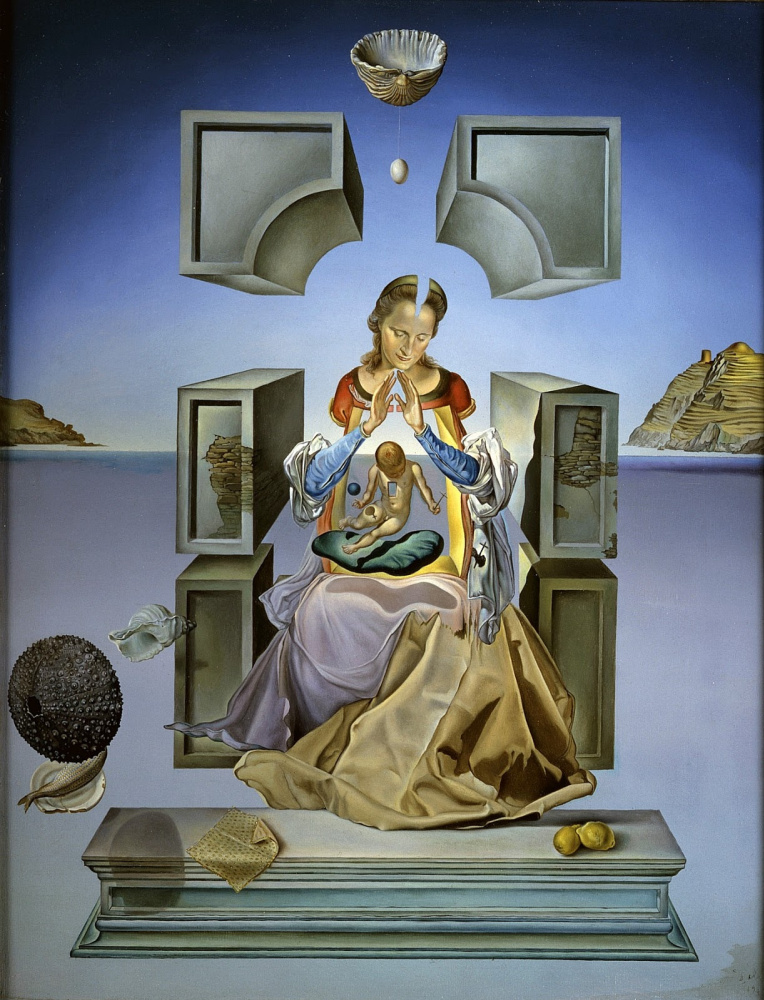log in
Enter site
Login to use Arthive functionality to the maximum
The Madonna Of Port Lligat
Salvador Dali • Painting, 1949, 368×246 cm
Description of the artwork «The Madonna Of Port Lligat»
This immense canvas, one of Dali`s most famous, marks the beginning of a new period in his work. At the same time, it is his first picture this large, it is the first of his religious paintings, and it heralds his corpuscular epoch.
The whole composition is arranged around the eucharistic bread visible thought a hole in the center of Jesus`s body, the point of intersection of the diagonal lines indicating the middle of the painting. Gala is depicted as the Virgin and also as the cuttlefish-angels on the right side of canvas. A little boy of Cadaques called Juan Figueras was used as the model for the infant Jesus. "Gala Madonna embodies all the geological virtues of Port Lligat," the painter wrote in 1956; "for example, the nurse, from whose back the night stand was taken, has this time been sublimated into the tabernacle of living flesh through which the celestial sky may be seen, and in turn another tabernacle cut from the chest of the infant Jesus, containing eucharistic bread in suspension." There are two oils of the same subject; this is the second one. The first, which is smaller in size, was submitted by Dali to Pope Pius XII for approval and is now at Marquette University. About the larger canvas, Dali has commented: "This picture because of its size was destined to know many mishaps. In the midst of an awful storm we had to have a contractor come to Port Lligat to enlarge the window in the room. Then Gala had to hire a truck, because it was to big for the train , to ship first to Paris and then to Le Havre, in order to ship it by boat to America. In New York, it was too big for any elevator; they had to hoist it up with a rope to the windows of the floor on which the Carstairs Gallery was located and where it was to be shown. The dealer, George Keller, himself said at the time, This painting is magnificent, but I will never be able to sell it, because there is no house big enough for it, and it costs to much to ship it around. It is, however, the one which opened the doors to the sale of all my large pictures."
Today The Madonna of Port Lligat is in the collection of Lady Beaverbrook in Canada. It is never shown in retrospective exhibitions because, in order to get it out, it would be necessary to knock down the door or take out one of the windows in the library where it hangs. (There is also a Madonna of Port Lligat II in Tokyo, apparently identical to this one, except that it is 144x96cm.)
The whole composition is arranged around the eucharistic bread visible thought a hole in the center of Jesus`s body, the point of intersection of the diagonal lines indicating the middle of the painting. Gala is depicted as the Virgin and also as the cuttlefish-angels on the right side of canvas. A little boy of Cadaques called Juan Figueras was used as the model for the infant Jesus. "Gala Madonna embodies all the geological virtues of Port Lligat," the painter wrote in 1956; "for example, the nurse, from whose back the night stand was taken, has this time been sublimated into the tabernacle of living flesh through which the celestial sky may be seen, and in turn another tabernacle cut from the chest of the infant Jesus, containing eucharistic bread in suspension." There are two oils of the same subject; this is the second one. The first, which is smaller in size, was submitted by Dali to Pope Pius XII for approval and is now at Marquette University. About the larger canvas, Dali has commented: "This picture because of its size was destined to know many mishaps. In the midst of an awful storm we had to have a contractor come to Port Lligat to enlarge the window in the room. Then Gala had to hire a truck, because it was to big for the train , to ship first to Paris and then to Le Havre, in order to ship it by boat to America. In New York, it was too big for any elevator; they had to hoist it up with a rope to the windows of the floor on which the Carstairs Gallery was located and where it was to be shown. The dealer, George Keller, himself said at the time, This painting is magnificent, but I will never be able to sell it, because there is no house big enough for it, and it costs to much to ship it around. It is, however, the one which opened the doors to the sale of all my large pictures."
Today The Madonna of Port Lligat is in the collection of Lady Beaverbrook in Canada. It is never shown in retrospective exhibitions because, in order to get it out, it would be necessary to knock down the door or take out one of the windows in the library where it hangs. (There is also a Madonna of Port Lligat II in Tokyo, apparently identical to this one, except that it is 144x96cm.)


